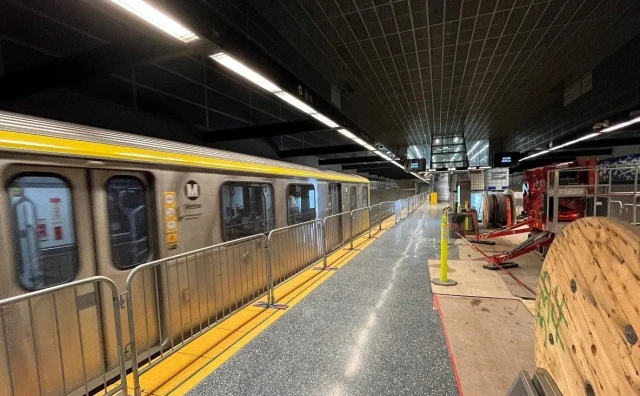With our free press under threat and federal funding for public media gone, your support matters more than ever. Help keep the LAist newsroom strong, become a monthly member or increase your support today during our fall member drive.
This archival content was written, edited, and published prior to LAist's acquisition by its current owner, Southern California Public Radio ("SCPR"). Content, such as language choice and subject matter, in archival articles therefore may not align with SCPR's current editorial standards. To learn more about those standards and why we make this distinction, please click here.
Why Does California Still Not Have An Earthquake Early Warning System?
Despite its ever-present warnings about how we California residents should be prepared for “The Big One,” our state government has no desire to pay for an earthquake early-warning system that could potentially save thousands of lives. According to the L.A. Times, it is not “policy” to use money from the state’s general fund to build a early-warning system.
A trio of state legislators believes this is nonsense, arguing that the state has a responsibility to ensure the safety of its residents. Coming just hours after a M. 6.4 Earthquake killed at least 14 people in Taiwan, State Senators Jerry Hill, from San Mateo, and Bob Hertzberg, of Van Nuys, along with Assemblymember Adam Gray, released a statement saying that California needs to act sooner than later to build such a system using money from the state’s general fund.
A 2013 law prohibits the state from building a system using general fund money, instead requiring the state to rely on public-private partnerships. Those partnerships have stalled, according to the L.A. Times, but the Big One is still coming.
Building an early warning system is entirely possible. Countries like Japan, Taiwan, China, Turkey, and Mexico all have them in place, giving people crucial seconds to duck under a table or evacuate before an earthquake’s shockwaves hit. When a M 9.0 Earthquake struck Japan in 2011, Tokyo residents had almost 70 seconds of warning before the shockwaves hit.
A system in California is proposed to cost $23 million, with an additional annual upkeep of $12 million. Figuring in the $16 million already supplied from the federal government to build an early warning system, that cost falls further.
$23 million dollars is a paltry sum for the state, especially when contrasted with the tens of billions (68 precisely) of dollars the state has no problem spending on a high-speed rail corridor through California. Yet for reasons unknown, the state has been reluctant to commit to building a system that warns people about an impending earthquake.
The state legislative analyst predicts California will end the next fiscal year with a reserve of $11.5 billion.
“We should use a small fraction of that money to make a smart, one-time investment in a system that can improve public safety and save lives,” the legislators said in a statement. “We share Gov. Brown’s commitment to fiscal restraint. However, to not invest a small fraction of the overall state budget to implement the earthquake early warning system would be fiscally irresponsible.”
In terms of particulars, an early warning system for California works by blanketing the system with sensors that transmit a warning signal if they detect shaking. Seismic waves move at approximately the speed of sound, significantly slower than the speed modern communications technology functions.
The end goal is to have a system that can warn people almost instantly when an earthquake starts nearby through their smartphones, computers, and televisions. Ideally, people could use the time between receiving a warning signal to drop and cover or evacuate. At the same time, this signal could be used to alert emergency services, stop trains and motion, and open elevator doors to prevent people getting trapped inside.
At LAist, we believe in journalism without censorship and the right of a free press to speak truth to those in power. Our hard-hitting watchdog reporting on local government, climate, and the ongoing housing and homelessness crisis is trustworthy, independent and freely accessible to everyone thanks to the support of readers like you.
But the game has changed: Congress voted to eliminate funding for public media across the country. Here at LAist that means a loss of $1.7 million in our budget every year. We want to assure you that despite growing threats to free press and free speech, LAist will remain a voice you know and trust. Speaking frankly, the amount of reader support we receive will help determine how strong of a newsroom we are going forward to cover the important news in our community.
We’re asking you to stand up for independent reporting that will not be silenced. With more individuals like you supporting this public service, we can continue to provide essential coverage for Southern Californians that you can’t find anywhere else. Become a monthly member today to help sustain this mission.
Thank you for your generous support and belief in the value of independent news.

-
Metro officials said it will be able to announce an opening date “soon.”
-
While working for the county, the DA’s office alleges that 13 employees fraudulently filed for unemployment, claiming to earn less than $600 a week.
-
The L.A. County Board of Supervisors on Tuesday voted to declare immigration enforcement actions a local emergency.
-
Tens of thousands of workers across Southern California walk out over pay and staffing issues.
-
People in and around recent burn scars should be alert to the risk of debris flows. Typical October weather will be back later this week.
-
Jet Propulsion Laboratory leadership says the cuts amount to 11% of the workforce.







